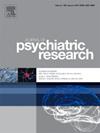Predictors of p factor scores in children with chronic physical illness
IF 3.7
2区 医学
Q1 PSYCHIATRY
引用次数: 0
Abstract
Background
The p factor represents the overall liability for the development of mental illness within individuals and we have previously validated a bi-factor model of the p factor in children with chronic physical illness.
Objective
In this next phase, we modelled predictors of the p factor in this sample of children.
Methods
Data come from the ongoing Multimorbidity in Children and Youth Across the Life-course study. Data from 263 children with a chronic physical illness aged 2–16 years and their parents were collected over 24 months. The parent-reported Emotional Behavioural Scales was used to develop a bi-factor model of the p factor. Subsequently, p factor scores were extracted from the model and standardized (Mean = 100, SD = 15). Analysis of variance compared p factor scores across different physical illnesses. Multiple regression was used to identify multilevel baseline predictors of p scores.
Results
There was no significant difference in p scores across categories of physical illness (F = 0.44, p = 0.849). Factors predictive of elevated p scores were older child age (B = 0.44), higher level of disability (B = 1.03), elevated parent psychopathology (B = 0.22) and stress (B = 0.21), and living in communities with older age and lower labor force participation (B = 1.66) and higher concentrations of racialized/newcomer populations (B = 2.05). Lower p scores were associated with being female (B = −3.85) and having immigrant parents (B = −5.43).
Conclusion
Factors predicting psychopathology, measured using p scores, in children with physical illness are multilevel. Fixed characteristics can inform targeted screening efforts, whereas modifiable characteristics are opportunities for upstream intervention in the context of family-centered integrated physical-mental health services.
慢性躯体疾病患儿p因子评分的预测因素
p因子代表了个体精神疾病发展的总体责任,我们之前已经验证了患有慢性身体疾病的儿童p因子的双因素模型。目的在下一阶段,我们将对儿童样本中的p因子进行建模。方法数据来自正在进行的儿童和青少年全生命历程多发病研究。在24个月内收集了263名2-16岁患有慢性身体疾病的儿童及其父母的数据。采用家长情绪行为量表建立p因子的双因素模型。随后,从模型中提取p个因子得分并进行标准化(Mean = 100, SD = 15)。方差分析比较了不同身体疾病的p因子得分。采用多元回归来确定p评分的多水平基线预测因子。结果各生理疾病类别间p值差异无统计学意义(F = 0.44, p = 0.849)。预测p值升高的因素有:儿童年龄较大(B = 0.44)、残疾程度较高(B = 1.03)、父母精神病理程度较高(B = 0.22)和压力(B = 0.21),以及生活在年龄较大、劳动力参与率较低(B = 1.66)和种族化/新移民人口集中度较高(B = 2.05)的社区。较低的p值与女性(B = - 3.85)和移民父母(B = - 5.43)有关。结论躯体疾病患儿心理病理的预测因素采用p评分法进行测量。固定的特征可以为有针对性的筛查工作提供信息,而可改变的特征则是在以家庭为中心的综合身心健康服务背景下进行上游干预的机会。
本文章由计算机程序翻译,如有差异,请以英文原文为准。
求助全文
约1分钟内获得全文
求助全文
来源期刊

Journal of psychiatric research
医学-精神病学
CiteScore
7.30
自引率
2.10%
发文量
622
审稿时长
130 days
期刊介绍:
Founded in 1961 to report on the latest work in psychiatry and cognate disciplines, the Journal of Psychiatric Research is dedicated to innovative and timely studies of four important areas of research:
(1) clinical studies of all disciplines relating to psychiatric illness, as well as normal human behaviour, including biochemical, physiological, genetic, environmental, social, psychological and epidemiological factors;
(2) basic studies pertaining to psychiatry in such fields as neuropsychopharmacology, neuroendocrinology, electrophysiology, genetics, experimental psychology and epidemiology;
(3) the growing application of clinical laboratory techniques in psychiatry, including imagery and spectroscopy of the brain, molecular biology and computer sciences;
 求助内容:
求助内容: 应助结果提醒方式:
应助结果提醒方式:


